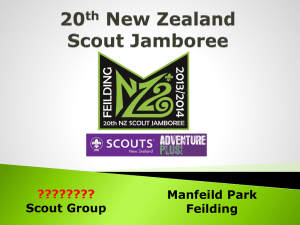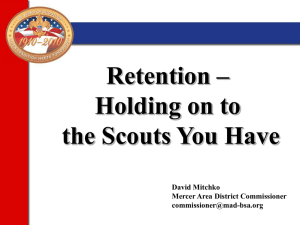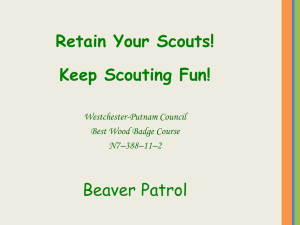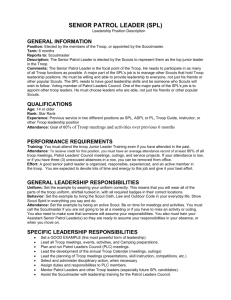Backpacking
advertisement
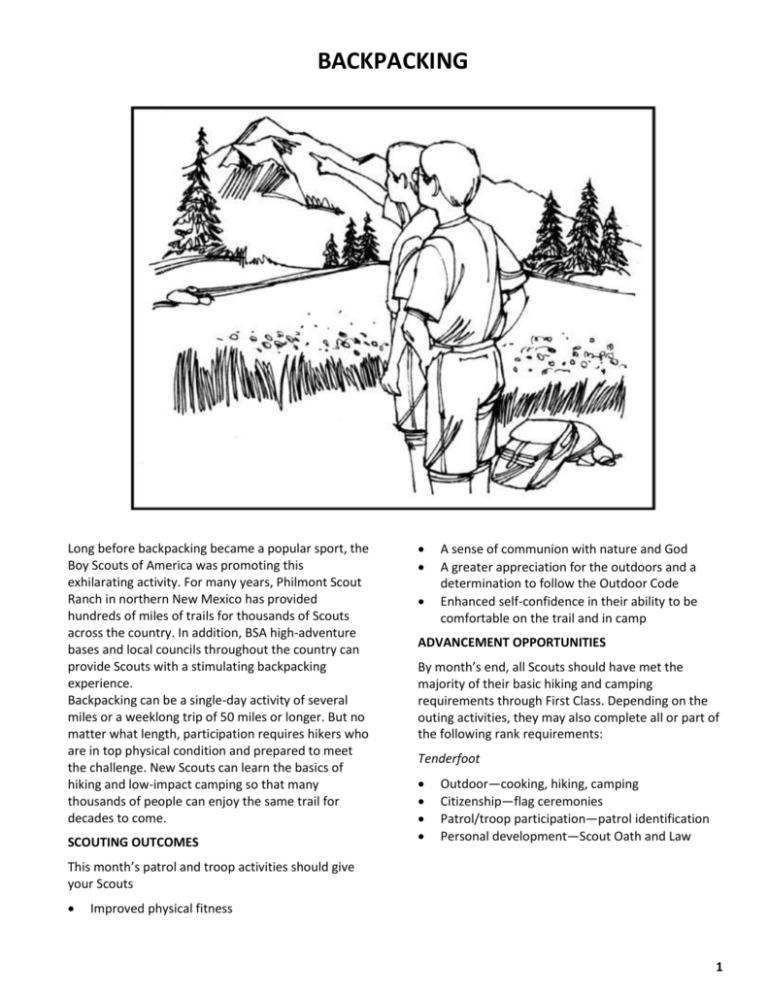
BACKPACKING Long before backpacking became a popular sport, the Boy Scouts of America was promoting this exhilarating activity. For many years, Philmont Scout Ranch in northern New Mexico has provided hundreds of miles of trails for thousands of Scouts across the country. In addition, BSA high-adventure bases and local councils throughout the country can provide Scouts with a stimulating backpacking experience. Backpacking can be a single-day activity of several miles or a weeklong trip of 50 miles or longer. But no matter what length, participation requires hikers who are in top physical condition and prepared to meet the challenge. New Scouts can learn the basics of hiking and low-impact camping so that many thousands of people can enjoy the same trail for decades to come. SCOUTING OUTCOMES A sense of communion with nature and God A greater appreciation for the outdoors and a determination to follow the Outdoor Code Enhanced self-confidence in their ability to be comfortable on the trail and in camp ADVANCEMENT OPPORTUNITIES By month’s end, all Scouts should have met the majority of their basic hiking and camping requirements through First Class. Depending on the outing activities, they may also complete all or part of the following rank requirements: Tenderfoot Outdoor—cooking, hiking, camping Citizenship—flag ceremonies Patrol/troop participation—patrol identification Personal development—Scout Oath and Law This month’s patrol and troop activities should give your Scouts Improved physical fitness 1 Second Class PARENT/GUARDIAN PARTICIPATION The patrol leaders’ council can involve parents in the program feature this month by Outdoor—cooking, camping, hiking, nature Citizenship—flag ceremonies Patrol/troop participation—patrol identification Personal development—Scout Oath and Law First Class • • • • Outdoor—cooking, camping, nature, hiking Citizenship—flag ceremonies Patrol/troop participation—patrol identification Personal development—Scout Oath and Law Merit Badges. Older Scouts can concentrate on the Backpacking and Hiking merit badges this month; they should be able to complete many of the requirements. Depending on activities during the month, they might also cover requirements in Camping, Cooking, Orienteering, Pioneering, Wilderness Survival, and other nature-related merit badges. Asking qualified parents to assist with instruction in camping and hiking skills Inviting parents on the backpacking outing Asking parents to provide transportation to the starting point for the hike, if necessary, and pick up at the end PATROL LEADERS’ COUNCIL The patrol leaders’ council should meet during the early part of the previous month to plan troop activities for this program feature. If you don’t complete all items on the following agenda, continue planning at patrol leaders’ council meetings after each troop meeting. Decide on the route and destination for the hike. If permission will be needed, assign someone to secure it. 2 Decide whether it will be a day outing or a longer trek. Review skills needed for the hike. If the troop will be camping overnight, plan special activities. If special gear will be needed, assign someone to obtain it; seek the troop committee’s help, if necessary. Plan details of troop meetings for the month. Assign patrol demonstrations, covering skills that will be needed for the hiking activities. FEATURE EVENT Backpacking Outing Backpacking offers a multitude of program adventures for your troop. A hike or trek allows Scouts to interact with nature, test their physical abilities, presents photo opportunities for any camera bugs, and helps new Scouts meet their hiking and camping requirements through First Class. You may want to organize the hike in stages, based on the skill levels and physical capabilities of the Scouts. One part could be relatively easy so that inexperienced Scouts can get a taste of backpacking. The second stage would give the more experienced young men a more challenging trail. Finally, the third stage would be a challenge for the older Scouts— almost a wilderness survival outing. Conduct various activities along the route. Depending upon the needs of the group, you may want to consider one or more of the following highlights: NATURE NOOK. Select a spot along the trail. Have each Scout select a 3-square-foot area and study wildlife within those boundaries. Note the plant life, animals, insects, etc. ENVIRONMENT PROJECT. Check with local conservation authorities for an appropriate Good Turn. Here are some possibilities. Plant tree seedlings or shrubs to provide food and cover for wildlife. Build a check dam, deflector, or cover device to provide shelter for fish and to reduce streambank erosion. Build and set out nesting boxes for birds and small mammals like squirrels and raccoons. Plant hedges or windbreaks to provide winter cover for wildlife. Protect a streambank by planting grass or trees. Control erosion on hiking trails by constructing water bars or spreading a layer of an organic material such as sawdust, wood chips, pine needles, or leaves on the trail surface. HOW TALL, HOW FAR? Locate a tall tree, mountain peak, cliff wall, etc., and have Scouts estimate its height and how far away it is. An unfamiliar route and destination would be best for the Scouts. Give them a topographic map and compass to find their way, or follow an established trail. 3 TROOP MEETING PLAN BACKPACKING Date ACTIVITY Week 1 DESCRIPTION RUN BY TIME Preopening Opening Ceremony 15 minutes Skills Instruction 30 minutes Patrol Meetings 10 minutes Interpatrol Activity 20 minutes Form patrols into an open square. Post the colors and repeat the Pledge of Allegiance. Troop recites the Scout Oath, Scout Law and Outdoor Code Adult Announcements Go over the Meeting Agenda New Scouts work on reading a compass and learn how to set a pace. Do Blindfold Compass Walk. (See the Games section of the Troop Program Resources.*) Experienced Scouts work on choosing boots for backpacking and begin planning a 20-mile hike. Older Scouts work on the Venture program. Review the principals of Leave No Trace and discuss ways they apply to the troop’s next outing. Discuss plans for this month’s outing and make sure everyone knows what his assignments are and what to bring for the outing. Any Scouts who have not been hiking yet will need some extra help. All other patrols can plan activities to work on advancement. Plan any meals that will be needed for the outing. If it will be an overnighter, plan now for equipment distribution and tent requirements. Play Hot Isotope Transport. (See the Games section of the Troop Program Resources.*) Patrol _ 7:00 PM SPL 7:15 PM PL 7:45 PM JASM 7:55 PM Run a mile and record the times. Closing 15 minutes After the meeting 15 minutes Announcements Scoutmaster minute Retire the colors As needed - Patrol Leaders’ Council reviews the next week’s Troop Meeting Plan and any upcoming troop outing. SPL 8:15 PM Patrol _ SPL 8:30 PM 4 TROOP MEETING PLAN BACKPACKING Date ACTIVITY Week 2 DESCRIPTION RUN BY TIME Preopening Opening Ceremony 15 minutes Skills Instruction 30 minutes Post the colors and repeat the Pledge of Allegiance. Troop recites the Scout Oath, Scout Law and Outdoor Code Adult Announcements Go over the Meeting Agenda New Scouts work on low-impact camping procedures, including site selection and cooking with Peak-type stoves. Experienced Scouts work on packing procedures for the backpacking outing and select some campsites based on a topographic map of the camping area. Patrol _ 7:00 PM SPL 7:15 PM Older Scouts work on the Venture program or make plans to sleep under a shelter made from natural materials as part of the troop outing. Patrol Meetings 10 minutes Review assignments for the campout. First-time hikers in the new-Scout patrol continue working on troop procedures for hiking and camping. All other patrols continue to plan activities for advancement. Practice interpatrol activities. Interpatrol Activity 20 minutes After the meeting 15 minutes 7:45 PM JASM 7:55 PM Run a mile and record the times. Do Silver Dollar Hunt. (See the Games section of the Troop Program Resources.*) Closing 15 minutes PL Announcements Scoutmaster minute Retire the colors As needed - Patrol Leaders’ Council reviews the next week’s Troop Meeting Plan and any upcoming troop outing. SPL 8:15 PM Patrol _ SPL 8:30 PM 5 TROOP MEETING PLAN BACKPACKING Date ACTIVITY Week 3 DESCRIPTION RUN BY TIME Preopening Opening Ceremony 15 minutes Skills Instruction 30 minutes Post the colors and repeat the Pledge of Allegiance. Troop recites the Scout Oath, Scout Law and Outdoor Code Adult Announcements Go over the Meeting Agenda New Scouts work on reading topographic maps and learn the symbols used on maps; also what to do if they get lost (Boy Scout Handbook). Play Map Symbol Relay. (See the Games section of the Troop Program Resources.*) Experienced Scouts plan projects that could be done along the hike route. Older Scouts work on the Venture program or help younger Scouts with topographic map orientation. Patrol _ 7:00 PM SPL 7:15 PM Patrol Meetings 10 minutes Finalize the menu for the hike this week and make sure everyone knows what he will need to bring. Review clothing and equipment needs, and collect the necessary fees. Go over the hike route. PL 7:45 PM JASM 7:55 PM Interpatrol Activity 20 minutes Play Ball-Over Relay. (See the Games section of the Troop Program Resources.*) Run a mile and record the times. Closing 15 minutes After the meeting 15 minutes Announcements Scoutmaster minute Retire the colors As needed - Patrol Leaders’ Council reviews the next week’s Troop Meeting Plan and any upcoming troop outing. SPL 8:15 PM Patrol _ SPL 8:30 PM 6 TROOP MEETING PLAN BACKPACKING Date ACTIVITY Week 4 DESCRIPTION RUN BY TIME Preopening Opening Ceremony 15 minutes Skills Instruction 30 minutes Post the colors and repeat the Pledge of Allegiance. Troop recites the Scout Oath, Scout Law and Outdoor Code Adult Announcements Go over the Meeting Agenda New Scouts work on first aid for blisters, cuts, and sprains. Experienced Scouts bring packs to the meeting and have a prehike inspection. Patrol _ 7:00 PM SPL 7:15 PM Older Scouts work on the Venture program or assist in teaching first-aid techniques. Patrol Meetings 10 minutes Review plans and assignments for the hike/campout. Make sure everyone knows the travel plans and equipment needs. Review the patrol duty roster. Practice any interpatrol activities that will take place during the hike. PL 7:45 PM JASM 7:55 PM Interpatrol Activity 20 minutes Do Star Hunt. (See the Games section of the Troop Program Resources.*) Run a mile and record the times. Closing 15 minutes After the meeting 15 minutes Announcements Scoutmaster minute Retire the colors As needed - Patrol Leaders’ Council reviews the next week’s Troop Meeting Plan and any upcoming troop outing. SPL 8:15 PM Patrol _ SPL 8:30 PM 7 TROOP OUTDOOR PROGRAM PLAN BACKPACKING Date: _____________________ TIME Friday evening 6:00 P.M. ACTIVITY Eat dinner before you arrive at the meeting location. Load gear and leave for camping area on time. At the campsite, off-load equipment and set up patrol sites. RUN BY SPL Cooks & assistants 11:30 A.M. Noon 4:30 P.M. Cooks and assistants up. Prepare breakfast. (Cooks should be working on First and Second Class requirements.) Everyone else up. Take care of personal hygiene, air tents, hang out sleeping bags. Breakfast Clean up Patrols clean up patrol site. Give patrol leaders a topographic map to make a 2- to 3-mile hike. The new-Scout patrol could take a simpler hike. Older Scouts could begin a 15- to 20-mile weekend survival hike. Sack lunch Continue hikes. Start dinner preparation and prepare campfire for evening. 5:30 P.M. 6:30 P.M. 8:00 P.M. 9:00 P.M. 9:30 P.M. 10:00 P.M. Dinner Clean up. Campfire Campfire ends Cracker barrel Lights out Sunday 7:30 A.M. 8:00 A.M. 8:30 A.M. 9:00 A.M. Cooks and assistants up. Prepare breakfast. (Cooks should be working on First and Second Class requirements.) Everyone else up. Take care of personal hygiene, air tents, hang out sleeping bags. Breakfast Clean up. Patrols clean up patrol site. Patrol games—run a 1-K orienteering course. Break camp and load personal gear into trailer. Leave for home Saturday 6:30 A.M. 7:00 A.M. 7:30 A.M. 8:00 A.M. 8:30–11:30 A.M. 9:30 A.M. 10:30 A.M. 11:00 A.M. Special equipment needed SPL/PL Cooks SPL Cooks/Fire Master SPL Cooks Cooks, & assistants Clean up Topographic maps, clipboards, compasses, troop camping equipment 8 BACKPACKING Scouting Games Week 1 Blindfold Compass Walk Equipment: For each patrol, eight small, numbered stakes; for each Scout, one orienteering compass and a large paper bag Procedure: Set the stakes in the ground 5 feet apart in a north-south line. One Scout from each patrol stands at each of the eight stakes. The Scouts from one patrol set their compasses between 45 and 135 degrees; boys from the opposing patrol, between 225 and 315 degrees. A paper bag is then placed over the head of each Scout, permitting him to see only the ground and the compass in his hand. Each Scout turns himself around three times, then follows the bearing on his compass for 100 steps. He then turns around and follows the bearing back (orienting the arrow toward himself instead of away) for 95 steps. Scoring: Only Scouts within 10 steps of their stake score. The patrol with the most points wins. Game Informal Patrol teams Hot Isotope Transport Equipment: A log, 6 to 8 inches in diameter and 10 inches long (the “radioactive isotope container”); a length of rope to mark a 20-foot circle; a 2- or 3-inch-wide rubber band cut from an inner tube (the “transporter”); several lengths of rope (tied to the rubber band) Object: To pick up the radioactive isotope container with the transporter, lift it out of the circle, and place it on the ground outside of the circle Procedure: Set the radioactive isotope container in the center of the rope circle. Have each patrol, in turn, line up around the circle. Each Scout grasps a rope. Under the patrol leader’s guidance, the Scouts pull the rope to stretch the rubber band, then bring the expanded band down over the container, relax the band to fit tightly around the container, then lift and deposit the container upright outside of the circle. Scoring: The patrol that completes the task in the shortest time wins. Variation: Instead of having only one container, have several containers. The patrol to transport out the most containers in a given time wins. Informal Knots Patrol teams 9 BACKPACKING Scouting Games Week 2 Silver Dollar Hunt Equipment: For each player, one orienteering compass, one “silver dollar” (a 3-inch cardboard circle covered with aluminum foil), one card with distances and directions such as “50 steps at [X] degrees (X being less than 120 degrees); 50 steps at [X + 120] degrees; 50 steps at [X + 240] degrees” Procedure: Scatter the players throughout a field of fairly tall grass. Place a silver dollar at the feet of each Scout. On signal, each Scout sets his compass for the direction indicated on his card and walks the specified distance. The same is done for the second and third bearings. When he is done, the silver dollar should be at his feet (or at least within his immediate sight). Scoring: The patrol with the most Scouts winding up within seven steps of their silver dollars (5 percent error) wins. Game Patrol teams Informal 10 BACKPACKING Scouting Games Week 3 Map Symbol Relay Equipment: Several identical flash cards of numbered map symbols, including contour lines (see the Boy Scout Handbook) Procedure: The patrols line up in relay formation facing a wall on which the map symbol flash cards (one for each patrol) have been posted. On signal, the first Scout from each patrol runs up, names the first symbol, runs back, and tags the next Scout, who runs up and names the second symbol. Continue the relay until all symbols have been named. Scoring: Score 2 points for each symbol correctly named and deduct 1 point for each symbol incorrectly named. The patrol that finishes first scores 10 points. Game Informal Patrol teams Ball-Over Relay Equipment: Ball, about basketball size; whistle; blindfold Procedure: Draw a line across the center of the game area, and assemble teams on either side of the line. The players take positions at various points on their side of the line; they cannot cross the line. One Scout is blindfolded and has the whistle. When he blows the whistle, the leader puts the ball into play. The players must try to keep the ball in the opposing team’s territory so that they don’t have possession of it when the blindfolded Scout blows the whistle again. The whistle should be blown fairly often, continuously starting and stopping play for a given time. Scoring: Deduct 1 point from the side that has the ball when the whistle is sounded. At the end of the game, the side with the lowest score wins. Game Patrol teams Whole troop 11 BACKPACKING Scouting Games Week 4 Star Hunt Equipment: Flashlight with a strong focusing beam Procedure: On a clear night, the patrols gather around a leader who knows the major constellations. He shines the light at a constellation. Each patrol quickly huddles to come up with the name of the constellation, then gives its patrol yell and announces the constellation’s name. Scoring: Award 1 point for each constellation correctly identified. The first patrol to finish wins. Active Game Patrol teams 12
